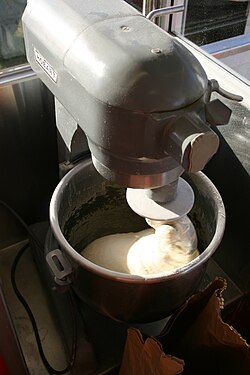Straight dough

Dough being mixed in a commercial planetary mixer.
|
|
| Main ingredients | Wheat flour, water. |
|---|---|
| |
|
Straight dough is a single-mix process of making bread. The dough is made from all fresh ingredients, and they are all placed together and combined in one kneading or mixing session. After mixing, a bulk fermentation rest of about 1 hour or longer occurs before division. It is also called the direct dough method.
A straight dough formula might look like this:
In general, the process steps for creating straight dough are as follows:
The straight dough method became popular after the discovery and later mass production of baker's yeast, as well as the mass production of mixing machines. Straight dough was simpler than sponge and dough, took less time and effort, and was considered superior for commercial purposes. Baking expert Julius Emil Wihlfahrt of The Fleischmann Company wrote,
Generally speaking, sponge is best used for fancy breads and straight dough for the average bread, for in this manner the advantages of both systems can be best appropriated.
Prior to 1920, there were two basic kinds of breads, naturally leavened French bread, and Vienna bread leavened with cereal press yeast, an early form of baker's yeast. After 1920, when mixing machines became popular among bakers, rural bakers began to make more sponge doughs and city bakers more straight doughs, both replacing sourdough. By the 1930s, straight dough had mostly replaced sponge dough, and the terms "French" and "Vienna" breads were used less often. Bakers who continued using older methods were generally unable to compete on a cost basis, and so with "rare exceptions," were limited to local niche markets.
...
Wikipedia
